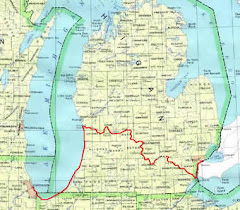
Sustenance and sanitation on our 1948 canoe trip (from the "Wooden Canoe" article):
"Their food guide was Deep River Jim's 'Grub list for a Two-Weeks' Cruise,' very heavy on bacon, flour, macaroni and beans. On Lloyd's Emporium's recommendation they added hardtack, dried fruit, Canadian canned butter, sugar butter and Cadbury's Carmello Chocolate Bars [the first time I had ever run into Cadbury's. I thought they were great, still do]. Their food supply, supplemented by unbelievably good fishing, turned out to be quite adequate and nourishing but they vastly underestimated their appetite for sweets. Exertion-driven energy demands and a shameful failure of self discipline caused them to deplete a two week's supply of sugar, candy, jam and syrup in five days."
"They were thus facing many days of desperation and possible sucrose starvation when a minor miracle occurred. They rounded a point on what they believed to be a wilderness lake when lo and behold, there was a fly-in fishing lodge with two good-looking Chicago girls in bathing suits sitting on the end of the dock! Grandpa said that it was indicative of the state of their desperation that they were as interested in the prospect of acquiring sugar as they were in the girls".
We prepared food pretty much the same way Hugh and his crew did in 1790. We cooked over an open fire and used mostly "squaw wood" for fuel. Squaw wood is firewood that you can gather without using tools. I had a good lightweight L.L.Bean Hudson Bay axe but seldom used it. I still have it. It is always part of my display at the annual Quiet Water Symposium. We had no stove, no fuel container, no propane, no butane, no Coleman fuel, no freeze-dried foil-packed meals, no saw, no fire pan, no reflector oven, no folding water bucket or cooler. We did have lots of waterproofed matches. We weren't up to flint and steel which is probably what Hugh and the Canadians used. After all, they carried flintlock muskets.
We prepared food pretty much the same way Hugh and his crew did in 1790. We cooked over an open fire and used mostly "squaw wood" for fuel. Squaw wood is firewood that you can gather without using tools. I had a good lightweight L.L.Bean Hudson Bay axe but seldom used it. I still have it. It is always part of my display at the annual Quiet Water Symposium. We had no stove, no fuel container, no propane, no butane, no Coleman fuel, no freeze-dried foil-packed meals, no saw, no fire pan, no reflector oven, no folding water bucket or cooler. We did have lots of waterproofed matches. We weren't up to flint and steel which is probably what Hugh and the Canadians used. After all, they carried flintlock muskets.
Hugh's crew probably cooked in copper trade kettles. We used a GI surplus nesting aluminum kettle kit topped by a steel fry-pan/cover with a folding handle. The biggest kettle served as our water bucket with the smaller ones for cooking. Our water came straight out of the river or lake, no filter, no chemicals.
We didn't have any trouble with critters getting into our food except for one morning I woke up and there was a skunk going through our stuff. You can be sure I laid there quietly so as to not disturb it until it was satisfied and wandered off. We just had to trim a little bacon.
Traveling through essentially endless wilderness, personal sanitation was no problem. We washed and bathed in the lakes or streams, although the water was too cold except for the briefest of swims. When nature called we would just slip out into the woods and scrape away a spot in the leaves or pine needles. We didn't even carry a shovel to make "cat holes". Our route was little travelled. We only saw one other canoe party the entire trip. Additionally, our jungle hammocks gave us the ability to camp where no tent-campers could. Contrast this with canoeing in the Boundary Waters now where you can only camp at designated sites with box latrines. Or contrast it with the way that Charlie Parmelee travels in his Kruger Sea Wind. He prides himself on no-trace camping, using a fire pan under his stove and some sort of traveling "Thunder Mug"---I've never actually seen it---so that the only sign of his presence might be some matted-down grass where his tent was pitched. He can even sleep in his canoe.
Here is Deep River Jim's "Grub List for two persons on a two-weeks' cruise into wilderness country":
6 lbs. Bacon 2 lbs. Cheese 1/2 lb. Cocoa
6 lbs. Flour 2 lbs. Dried Lima Beans 4 lbs.Corned Beef Hash
3 lbs. Onions 2 lbs. Dried Prunes 2 lbs. Powdered Milk
3 lbs. Cornmeal 1 lb. Dried Apricots 3 lbs. Baked Beans (cans)
3 lbs. Sugar 1 lb. Pea Soup Powder 3 lbs. Tomatoes (cans)
2 lbs. Raisins 1 lb. Chipped Beef 2 lbs. Corn (cans)
2 lbs. Rice 1 lb.Dehydrated Potatoes 2 lbs. Macaroni
The only carried food mentioned in Hugh Heward's journal was pork and corn. Catching, netting or spearing fish would have been easy and they had muskets for killing game. The French explorer LaSalle in his account about walking across the Lower Peninsula in the spring of 1680 tells of shooting stag (deer), bear and turkey for food. They carried flintlocks too.
NEXT: Journals


No comments:
Post a Comment